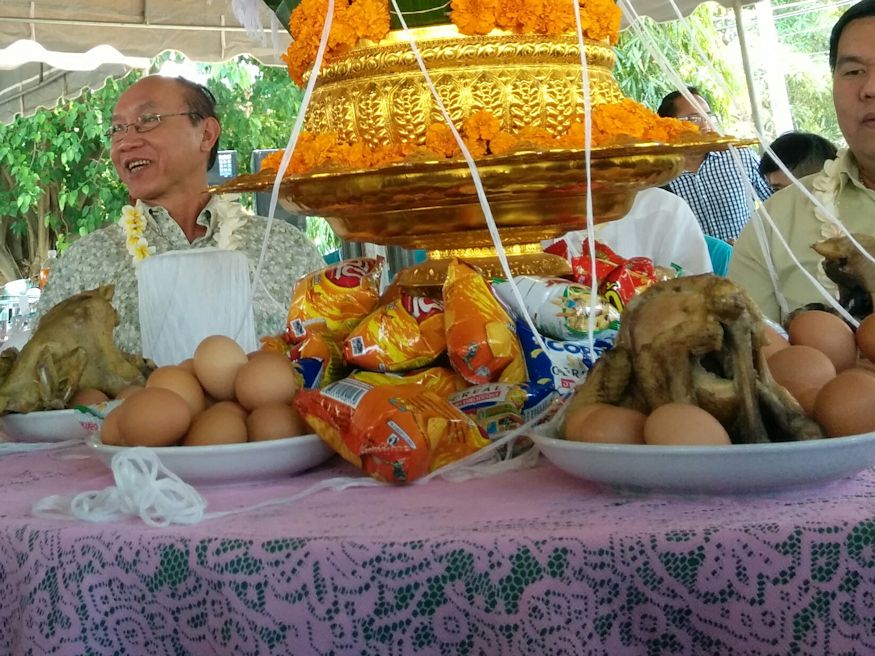Baci Ceremony Travel Guide
What is a “baci” anyway?
A baci ceremony is uniquely Lao, and it’s basically a good luck ceremony to celebrate big life events, such as a wedding, a new baby, or a new job. FocusAsia Travel shares you everything you should know about Baci Ceremony travel guide .
Another type of baci is a kind of group baci held for important holidays. At this baci everyone attending gets a piece of the luck. Including you!

What happens at a Lao baci?
A baci is (usually) performed by an old dude. As a former monk, he is qualified to perform a baci.
At the center of the baci is the “pha khuan”. Made of banana leaves and marigolds, this centerpiece ranges from portably small to ridiculously huge, depending on what the family can afford. Obviously, bigger is more impressive (and maybe gives better luck?). The person performing the baci sits beside the pha khuan, in the middle of the ceremony.

You’ll (hopefully) be pointed to one of the chairs arranged around the pha khuan. No chairs? Sit on the floor.
Before the baci begins, the organizers sling white strings from the pha khuan to the attendees, spanning out like a spider web. If someone passes you a string, put it between your thumb and forefinger of one hand and place your palms together so you’re doing a nop with the string. Pass the long string back to the next person.
Maybe you can only use 1 hand (maybe you’re holding your phone to take a selfie?) which makes it difficult to nop. In that case, put the string between your thumb and forefinger so you’re doing kind of a half-nop.
Note: it’s OK to take photos with your phone during a baci. I’ve taken photos (obviously), and I’ve seen some pretty shameless selfies by baci participants.

The baci begins when the old guy starts chanting. He’ll be chanting in a language that isn’t Lao – it’s baci language!
At certain points (that everyone seems to know), rice gets tossed and everyone shouts “Eehhh!” at the same time. Feel free to join in.
Near the end of the baci, people reach forward to touch the pha khuan. This is your cue to reach forward too. If you can’t reach the pha khuan, gently put your hand on the person in front of you. I think this channels the luck through everyone (or something?).
Note: Since I was wasn’t too sure about this, I kind of hung on to the shirt of the person in front of me. It seemed to work OK.

When the chanting ends, the baci ends. At this point the people closest to the pha khuan collect the white string and cut it into small strips. These strips get tied onto peoples’ wrists to give luck.
Tying the baci string
To tie a baci bracelet onto someone’s wrist, the first thing you do is tie a knot in the middle (so it doesn’t fall apart or separate).
Then, find someone you want to wish luck to (probably the person the baci is held for; at a group baci, anyone will do). When the person you’ve found holds out their wrist, take the string from underneath and tie it on top. When you tie it be sure to:
- a) not cut off circulation, and
- b) say something nice about wishing them luck, wealth, health, happiness, and safe journey, or whatever is appropriate in the situation
Once you’re finished your blessing, rub the string lightly to “press the luck in real good” (my own interpretation).
Because you’re a foreigner (I assume you are, if you’re reading this), you’ll probably gets tons of people tying strings on you. Be gracious and thank everyone. Don’t worry if you don’t tie too many on others.

Around the pha khuan you’ll see food – crackers, eggs, glasses of whiskey or beer, and a whole boiled chicken (seriously). Eating this stuff is part of the baci. When someone ties a baci string on your wrist, you might have a boiled egg, a package of crackers, or a glass of beer thrust into your hand. Hold your gift until the baci string is tied on. Then you can consume your snack.
Note: The boiled chicken gets passed around and pulled apart by many hands and eaten in pieces. If you’re not into this kind of sharing, just find a reason to walk away when the boiled chicken gets near you.

What do I wear to a Lao baci?
Dressing nicely for a baci shows respect for the host and for the ceremony. I’m all for individuality, but I also don’t want to destroy international relations expressing my individuality with a crop top.
For women, wear a sinh. Yes, it’s easy as that. Wear a nice shirt and avoid flip flops. Sandals are fine but the flip flops lower the bar on class.
For men, wear a collared shirt (no T-shirt) and light pants. Try not to wear shorts (lowers the class big time). Also, try to wear lace-up shoes (no sandals or flip flops if you can help it).
What else do I need to know?
There are a few random things that could catch you off guard at a baci. These tips will help make your baci experience go smoothly.
How to give money at a baci
At a baci you usually give money. If you get a formal paper invitation it’s really easy to get the money where it needs to go. The envelope will (hopefully) have your name on it – put your money inside and take it with you to the baci.
As I understand it, the going rate for a baci is 100,000 kip (maybe I’m a sucker, but that’s what I give every time). Hand your envelope to the host or the person the baci is for. I don’t think there’s a right or wrong time to do it but be sure to do it before you leave.
If you don’t have an invitation you can fold up the money accordion-style and tie it onto the wrist of the baci-beneficiary with a baci string. Check his or her wrist to see if anyone else did the same thing – then you’ll know it’s OK.
If you’re at a group baci, you probably won’t have an invitation so don’t worry about the money (I didn’t at least).
The after-party
After the baci is a “small party” with tons of Lao food and Beer Lao. Feel free to stay and partake (after all, your 100,000 does pay for some of it).
If you’re not familiar with Lao Food, take a look at Strange Food: What do they REALLY eat in Lao? so you’re not shocked by the unfamiliar morsels on your plate.
What to do with the baci strings on your wrist
The baci strings are the embodiment of luck from the ceremony, and they should stay on your wrist for at least 3 days for the luck to take effect. Ideally, they should fall off by themselves (but not everyone can wait that long).























